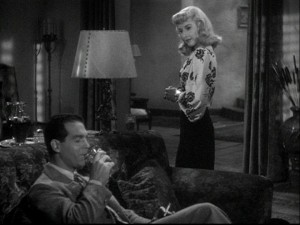In class on Thursday when we were discussing how a film could cue us to the subjectivity of the narration since, by default, a film is expected to utilize objectivity; similarly, the audience’s expectations, guided by cognitive norms, submit to the same objectivity. As I reflected about this notion, one film in particular struck me as representing subjective narration both diegetically and mimetically. 
Double Indemnity, a seminal film noir from 1944, concerns an insurance rep who “lets himself be talked into a murder/insurance fraud scheme that arouses an insurance investigator’s suspicions (imdb.com).” Now, this plot summary does no justice to the complexity of the story, but this film noir hits all of the right notes: expressionistic lighting, femme fatale, murder, fatalism, crime, etc… Honestly, if you haven’t seen it, you must, and I apologize in advance if I reveal key events from the plot/discourse that could ruin your viewing experience.
Double Indemnity immediately cues us diegetically to its subjectivity by the narrator/protagonist framing the narrative with a confession of murder and the events leading up to that murder. Visually, we see the protagonist, Walter Neff, telling his story via a dictaphone. From this point on, the voice-over narration guides us into the body of the plot and how Neff became beguiled by both the femme fatale and thus the murder plot. What all of these techniques denote is the subjectivity of the events that follow: Neff is guiding us through the events, naturally providing us with one skewed (in my mind) perspective of the events leading to his eventual demise. What I think the film does very well is mimetically convey the inner conflict of Neff as he tells his story; almost as if the mise-en-scene visually invokes the emotional state of the fated character. It is as if the audience sees externally what Neff feels internally while narrating the tale. In one particular scene (the one in the photo above), Wilder constructs settings using both obtuse, Expressionistic lighting techniques to convey the turmoil of Neff. Furthermore, Wilder also prominently displays doorways, windows, portraits, and other architectural elements that appear as closed boxes or frames; as I saw it, visual cues suggesting Neff’s feeling of being trapped and unable to escape from his inevitable fate.
As I think we certainly showed in class, film diegesis and mimesis exist simultaneously within any film. They exist as weights on a scale: sometimes, more weight is placed on one aspect over the other. In this case, the narrative framework and plot construction of the story and its inherent subjectivity are complimented by aspects of set design and mise-en-scene that reveal the mental status of the narrator/protagonist.